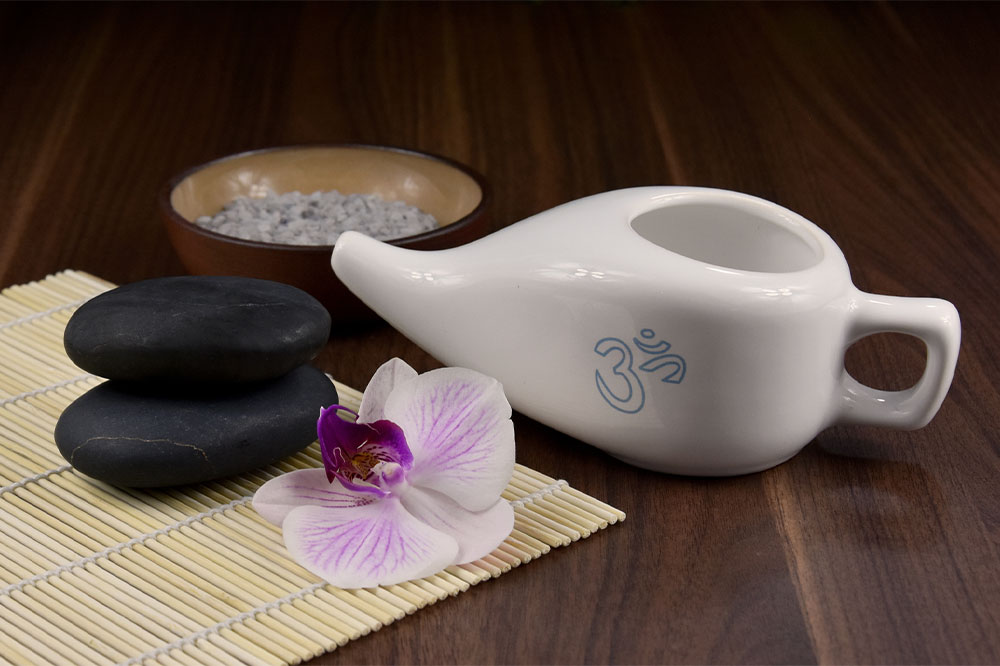8 effective remedies for nasal polyps

Nasal polyps are tiny tear-shaped growths in the nose and sinuses, usually brought on by asthma, infection, allergies, or other kinds of inflammation. These polyps are usually painless and non-cancerous, however, they can be big enough to cause itchiness, breathing difficulties, sneezing, and running nose. Doctors usually prescribe nasal sprays that can relieve the symptoms and get rid of the polyps. However, one can also try a few natural remedies to deal with the condition:
Neti pot (or nasal irrigation)
Neti pot is a popular and convenient nasal irrigation device. All one has to do is fill this container with saline solution or add 1–2 tsp salt to distilled water or boiled (and then cooled) tap water. Then, one would have to lean over a washbasin or a sink and tilt their head sideways so that the liquid does not flow back into the mouth. One would have to breathe through the mouth, insert the spout into the upper nostril and allow the fluid to drain from the lower nostril. Then the nostrils will have to be cleaned by blowing the nose to remove mucus and dirt. This process should be repeated through the other nostril. The goal is to loosen and clear the mucus and debris like dust or pollen from the nasal cavity. Using a neti pot twice a day can help improve symptoms of nasal polyps. The container and hands have to be clean and dry to prevent infection.
Steam inhalation
In the absence of a nasal irrigation device, one can use steam to relieve nasal congestion, headaches, and other symptoms. People can boil some water in a pot or dish, place it on a counter or the dining table right in front of them as they sit in a comfortable position, and inhale the steam for a while. The head and the pot should be covered with a thick towel so that the steam does not escape. One can also add essential oils to the water for more effective results.
Ginger
Ginger is a herb that exhibits antibacterial and anti-inflammatory properties, making it a common remedy for cold and cold-like symptoms. Fresh ginger root or dry ginger powder can be added to curries, salads, and even tea to help soothe inflammation, clear a runny nose, and breathe easier. One can also add fresh pieces of ginger to boiling water and have a cup two times twice a day for quick relief from the symptoms.
Apple cider vinegar
Apple cider vinegar has antimicrobial and antiseptic properties that can help loosen up the mucus, relieving symptoms of nasal polyps. This remedy can be used by combining two tablespoons of apple cider vinegar in a glass of water and drinking it two or three times a day for quick relief.
Cayenne pepper (or capsaicin)
Cayenne pepper contains a compound called capsaicin that helps open up nasal passages, control inflammation, and improve immunity. The spice can be added to food or even hot cayenne tea by adding 1 tsp of cayenne pepper to boiling water along with brown sugar, coconut sugar, or honey as the sweetener. Herbs can also be added to improve the flavor.
Turmeric
This spice can reduce the inflammation in the airways and relieve breathing difficulties. Ground turmeric or powder can be added to food. People with nasal polyps can also add fresh turmeric root or powder and a dash of pepper to a warm glass of milk and have it two times every day. This drink can help relieve the symptoms and get a good night’s sleep.
Essential oils
Essential oils are concentrated compounds extracted from plants that have been used for centuries to treat illnesses. Eucalyptus, peppermint, oregano, and tea tree essential oils are effective in relieving irritation, inflammation, and other nasal polyp symptoms. Dilute these oils by combining 5–7 drops with water, and then use an essential oil diffuser. Or adding a few drops of these oils to the bath water, allowing gradual inhalation. Those with severe symptoms can rub a drop of the oil on their palms, handkerchief, or a cotton swab and then inhale it. Massaging a drop of oil on the forehead or back of the neck can also help dislodge the mucus. Always buy certified essential oils and check for adverse reactions before use. Also, ensure that these oils are not ingested or used internally.
Nasal strips
Nasal strips can target symptoms like nasal congestion, sinusitis, and breathing difficulties. This can be used by those who have sensitive skin, as the strip is easy to apply and remove. These tiny self-adhesive strips can provide quick relief from the symptoms associated with nasal polyps. The strips are placed along the bridge of the nose, right above the nostrils. Once applied, the strip gently pull on the openings of nostrils, widening them in the process and making it easier to breathe. The strip can be used for up to 12 hours during the day or, preferably, while sleeping.
Sprays for nasal polyps
Home remedies help relieve symptoms but may not be able to get rid of the polyps. Doctors can recommend treatment options and even surgery, however, nasal polyps are likely to return even after surgical treatment. So, doctors usually prescribe nasal sprays are usually prescribed to ease the symptoms and shrink the polyps. These sprays should ideally be used only for a month after consulting with the doctor. Some effective sprays that relieve nasal polyps are Flonase, Nasonex, and XHANCE.






